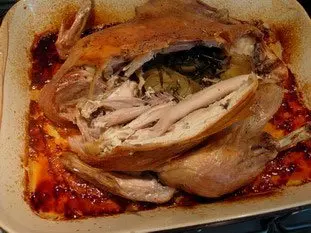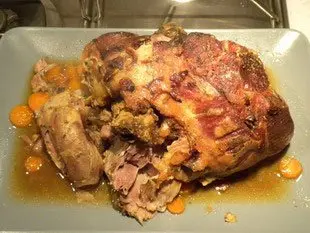The blog of cooking-ez.com
In praise of slow cooking

You will no doubt have noticed that in cookery, it's often the actual cooking process that gets neglected. This is understandable; it comes at the end of the recipe and getting the dish in the oven is something of a relief (ah, that's done!), which frees us to cope with what's left: tidying the scene of the action, doing the washing up.. or starting on another recipe.
37K 21 4.2
Last modified on: February 9th 2011
In praise of slow cooking
For a lot of dishes, whether they're cooked fast or slow, hotter or cooler, doesn't really matter. Take a cake for example, as long as it's not actually burnt, when it's done, it's done and it needs to come out of the oven otherwise it will start to dry out and harden, then burn.
But for plenty of other dishes, and especially those containing vegetables or meat, it's possible to use another style of cooking, known as “slow cooking” or “low temperature cooking” .
The principal is as simple a it gets: we turn down the heat and increase the length of cooking time accordingly. The cooking time is therefore much longer, but as the temperature is so much lower than normal, the dish doesn't burn.
This is not a recent discovery of molecular cuisine or the like, it's a principal as old as the hills which we're only now rediscovering.
With this long, slow cooking – and it is real cooking – the ingredients are not shocked by the oven temperature, but gently brought up to the right temperature. A renowned dish of French cuisine which uses this method is the famous “seven-hour lamb” (leg of lamb).
This has two major consequences:
1) The food doesn't dry out. This applies to meat in particular, which stays tender and develops a melting texture (you can break it apart with a fork).
2) Flavours are enhanced, as the process favours the famous Maillard reactions.
So, in short, there is everything to be gained, the only drawback being the extra time required for dishes to be properly cooked, which may not always be available.
One concrete example: to roast a chicken by the conventional method, the oven is normally set to 220°C (430°F) for about 45 minutes. The result is a roasted, browned chicken that's already rather good.
For slow cooking, the same chicken can be put in the oven at 140°C (280°F) for 5 hours, and the result is a roast chicken with an amazing flavour and so tender that it can be eaten simply with a fork; the meat just falls off the bones, even on the drumsticks.
It's five hours poultry.
The same process can be prolonged even further by putting the same chicken in a cooking bag with vegetables and whatever herbs you choose into the oven at 100°C (210°F) for 12 hours. You'll be surprised at the result.
To round up, don't forget that slow cooking is more of a method than a recipe, so the temperature and time are not necessarily exact. You just need to keep the temperature below 150°C (300°F) and above 80°C (180°F), then alter the cooking time depending on the result you wish to achieve, but with a minimum of 2 hours. The simple rule is this: the lower the temperature, the longer the cooking time needs to be.
One tip, even so : if you want to slow cook a piece of red meat, it will look much more appetising if you seal it on each side for one minute in a little really hot oil, and only then put it on to cook slowly.
But for plenty of other dishes, and especially those containing vegetables or meat, it's possible to use another style of cooking, known as “slow cooking” or “low temperature cooking” .
The principal is as simple a it gets: we turn down the heat and increase the length of cooking time accordingly. The cooking time is therefore much longer, but as the temperature is so much lower than normal, the dish doesn't burn.
This is not a recent discovery of molecular cuisine or the like, it's a principal as old as the hills which we're only now rediscovering.
With this long, slow cooking – and it is real cooking – the ingredients are not shocked by the oven temperature, but gently brought up to the right temperature. A renowned dish of French cuisine which uses this method is the famous “seven-hour lamb” (leg of lamb).

This has two major consequences:
1) The food doesn't dry out. This applies to meat in particular, which stays tender and develops a melting texture (you can break it apart with a fork).
2) Flavours are enhanced, as the process favours the famous Maillard reactions.
So, in short, there is everything to be gained, the only drawback being the extra time required for dishes to be properly cooked, which may not always be available.
One concrete example: to roast a chicken by the conventional method, the oven is normally set to 220°C (430°F) for about 45 minutes. The result is a roasted, browned chicken that's already rather good.
For slow cooking, the same chicken can be put in the oven at 140°C (280°F) for 5 hours, and the result is a roast chicken with an amazing flavour and so tender that it can be eaten simply with a fork; the meat just falls off the bones, even on the drumsticks.
It's five hours poultry.

The same process can be prolonged even further by putting the same chicken in a cooking bag with vegetables and whatever herbs you choose into the oven at 100°C (210°F) for 12 hours. You'll be surprised at the result.
To round up, don't forget that slow cooking is more of a method than a recipe, so the temperature and time are not necessarily exact. You just need to keep the temperature below 150°C (300°F) and above 80°C (180°F), then alter the cooking time depending on the result you wish to achieve, but with a minimum of 2 hours. The simple rule is this: the lower the temperature, the longer the cooking time needs to be.
One tip, even so : if you want to slow cook a piece of red meat, it will look much more appetising if you seal it on each side for one minute in a little really hot oil, and only then put it on to cook slowly.
Lasts posts
Don't throw away disposable piping bags
Nowadays, it's fairly easy to find what professionals use as piping bags, i.e. disposable or "single-use" plastic ones. They're practical, functional and inexpensive, but disposable? That's debatable...229 May 28th 2024
Should asparagus really be cooked in bunches?
You'll probably read recipes here and there explaining how to cook asparagus "en botte", i.e. in a small package (the famous "botte"). Is this really the right way to cook asparagus?795 May 22th 2024
Wipe meats and fish before cooking
When you want to cook meat or fish, there's a very simple yet very important step to take before you even start: It's to dry, or wipe, each side of the meat or fish, sometimes called "dabbing" or "sponging". But why? And how? Let me explain.2,5025 April 14th 2024
Toss the salad
When you've finished preparing a salad, green or otherwise, it's usually time to add the dressing and toss. It's often said to "toss the salad", which means to season and mix. Is it easy? Not so easy...3,6585 March 8th 2024
Half milk, half cream
In a multitude of recipes, savoury or sweet, milk is used as the main ingredient, or at least as the main liquid ingredient. Milk is used instead of water, for example, because milk contains a proportion of fat, which adds roundness and softness to the recipe. This mellowness is very pleasant on...3,513 February 27th 2024
Other pages you may also like
What is the difference between bakery and patisserie?
This is a question that you may well have asked yourself and which I will attempt to answer. In France the two trades of "boulangerie" (bakery) and "pâtisserie" (patisserie and confectionery) have always been quite distinct, but where exactly do the boundaries lie? .120K 14.1 February 7th 2017
The 3 essential knives
You must have heard a chef or cook say: "There’s no good cooking without good ingredients". This is very true, of course, but for any amateur or beginner it is equipment that really counts to start with. What I mean is that you should not skimp on kitchen equipment, good utensils, a food...20K5 May 30th 2018
A memo of utensil weights
You will no doubt have come across this problem while cooking: after starting a recipe, when you already have some ingredients in a pan and have maybe cooked them, you need to know the weight of the pan's contents so that you can take half out, or add the same weight of sugar, for example.23K4.6 May 9th 2011
Should I believe my oven?
Can you really trust your oven? This is an important question as we are always tempted to take the temperature indicated as gospel truth and, unfortunately, this is rarely very precise. .27K4.6 July 4th 2011
A few tips for effective kneading at home
When you have to knead dough for bread or some other recipe, you may well use a food processor or the type of machine known as a stand mixer. The best-known brands are Kenwood and KitchenAid. They are useful tools, but here are a few tips to help you get the best out of them.267K 23.7 June 23th 2021
Follow this page
If you are interested in this page, you can "follow" it, by entering your email address here. You will then receive a notification immediately each time the page is modified or a new comment is added. Please note that you will need to confirm this following.
Note: We'll never share your e-mail address with anyone else.
Alternatively: you can subscribe to the mailing list of cooling-ez.com , you will receive a e-mail for each new recipe published on the site.









